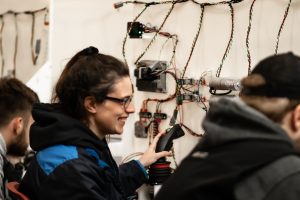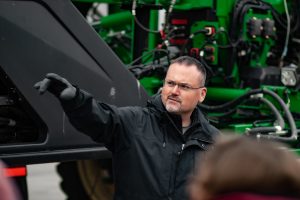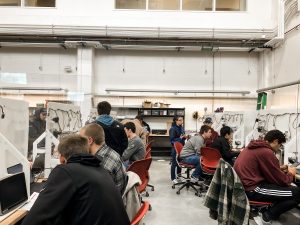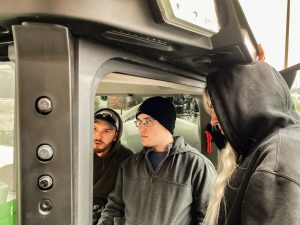
In ABE 410, class is about not only machine design, but also about learning how to design, communicate and operate projects in an ever-changing and always advancing field: ag automation. Agriculture is one of the fastest moving fields in regards to technology – designing successful autosteer features for tractors as early as 1999.
As technology continues to grow faster and faster, Department of Agricultural and Biosystems Engineering professor and researcher Matt Darr wants to ensure that the students that graduate from the department are trained to adapt and solve problems in the complex world of ag technology.
Darr’s main lesson that he teaches in ABE 410 is exactly that: how to succeed and innovate in a highly complex and technologically advanced environment. Over the semester, students build automated systems that link mechanical, electrical and hydraulic components together. Through projects like these, the students gain hands-on experience and take away team-building and communication skills.

“In this class, we are teaching students how to communicate, work in teams, how to define system requirements, how to troubleshoot, and ultimately deal with complex challenges and issues that are real when you are trying to build intelligent, integrated, and automated off-road machines,” Darr said. “We are training the students exactly how things work in the industry today.”
In the class, Darr makes sure students get the chance to see their coursework in action. Darr arranges a day for the students to see what their projects look like in the industry by bringing in a self-propelled sprayer with an automated system similar to their project.
“As a student, you don’t know how things are done in industry yet. In the lab, you are taking the training equipment that we use, plugging it into a machine, pressing a joystick button and seeing a machine move,” Darr said. “Seeing the self-propelled sprayer reinforces to them that this is real – this is how innovations are made.”

This class project takes up the last half of the semester for the students. Up until the last three weeks, each student worked on their project with one partner and a trainer. But toward the end, the students connected all of their projects together and watched everything align.
“Up until the end of the semester, the labs have been the student, their partner and their trainer. They can control their whole world, without having to communicate with others. But in the last part, they are working together and pushing one button over here, and the actuator is moving at the end of the row,” Darr said. “So it’s really about the communication piece, and about how you start to think of yourself as part of a community that is building something as a team. Those system level requirements and communication skills are ultimately a highlight and core curriculum goal for this course.”
And after watching their weeks of hard work and research work together, and then seeing the self-propelled sprayer use machines almost identical to what they created, the students are able to directly translate their class projects to real innovations. It’s more about the ability to see that translation than the actual technical aspects, according to Darr.

“Students walk away with a reinforcement of the applicability and how what we are doing here models what is happening in real life, and get excited to see that direct impact.”
In a discipline that is ever-changing, it’s important for the students to get exposure to industry work, collaboration, communication and other fields of study. In the class, it’s not just ABE students – classmates range from electrical engineers, to software engineers, and several other curriculums.
“Today’s world is more complex,” Darr said. “As a department, we’ve recognized that, we have championed being a leader to transition our curriculum to support that. This is not the same degree that you got in ABE fifteen years ago. We are really trying to maintain our cutting-edge approach and make sure that as the industry evolves, we evolve with it.”
